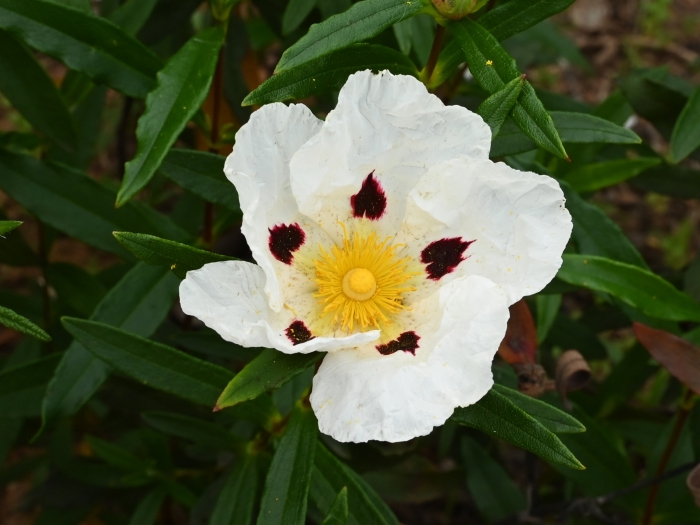Common Gum Cistus
(Cistus ladanifer)
Common Gum Cistus (Cistus ladanifer)
/
/

Krzysztof Ziarnek, Kenraiz
CC BY-SA 4.0
Image By:
Krzysztof Ziarnek, Kenraiz
Recorded By:
Copyright:
CC BY-SA 4.0
Copyright Notice:
Photo by: Krzysztof Ziarnek, Kenraiz | License Type: CC BY-SA 4.0 | License URL: https://creativecommons.org/licenses/by-sa/4.0 | Uploader: Kenraiz | Publisher: Wikimedia Commons | Title: Cistus_ladanifer_kz25.jpg | Notes: Uploaded own work with UploadWizard |














































































Estimated Native Range
Summary
Cistus ladanifer, commonly known as Common Gum Cistus, is an evergreen shrub native to the Mediterranean region. It typically grows to a height of 3-5 feet and a width of 3-4 feet. The plant is characterized by its lance-shaped, dark green leaves and large, showy flowers that bloom in late spring to early summer. Each flower is 5–8 cm in diameter, with five papery white petals, often featuring a red to maroon spot at the base, which encircle the prominent yellow stamens and pistils. The foliage and stems exude a sticky, fragrant resin called labdanum, historically used in herbal medicine and perfumery.
Common Gum Cistus is valued for its aromatic foliage, ornamental flowers, and adaptability to poor soils and drought conditions, making it suitable for xeriscaping. It is often used in gardens for mass plantings, as a specimen shrub, or in Mediterranean-style landscapes. This plant thrives in full sun and well-drained soils, tolerating a range of soil types, including rocky and infertile soils. It requires little maintenance once established but is sensitive to overwatering and cold temperatures. The plant has received the Royal Horticultural Society’s Award of Garden Merit, indicating its excellence for garden use. Potential problems include susceptibility to fungal diseases in humid conditions and damage from frost in colder climates.CC BY-SA 4.0
Common Gum Cistus is valued for its aromatic foliage, ornamental flowers, and adaptability to poor soils and drought conditions, making it suitable for xeriscaping. It is often used in gardens for mass plantings, as a specimen shrub, or in Mediterranean-style landscapes. This plant thrives in full sun and well-drained soils, tolerating a range of soil types, including rocky and infertile soils. It requires little maintenance once established but is sensitive to overwatering and cold temperatures. The plant has received the Royal Horticultural Society’s Award of Garden Merit, indicating its excellence for garden use. Potential problems include susceptibility to fungal diseases in humid conditions and damage from frost in colder climates.CC BY-SA 4.0
Plant Description
- Plant Type: Subshrub, Shrub
- Height: 3-5 feet
- Width: 3-4 feet
- Growth Rate: Rapid
- Flower Color: White
- Flowering Season: Summer
- Leaf Retention: Evergreen
Growth Requirements
- Sun: Full Sun
- Water: Medium, High
- Drainage: Medium
Common Uses
Bank Stabilization, Bee Garden, Bird Garden, Border Plant, Butterfly Garden, Deer Resistant, Drought Tolerant, Fragrant, Groundcover, Low Maintenance, Rock Garden, Salt Tolerant, Showy Flowers, Street Planting
Natural Habitat
Native to the Mediterranean region
Other Names
Common Names: Labdanum, Brown-Eyed Rockrose, Gum Rock Rose, Lack-Zistrose, Jara, Labando, Ladanumcistros
Scientific Names: , Cistus ladanifer, Cistus ladaniferus, Cistus ladanifer var. albiflorus, Cistus ladanifer f. immaculatus, Cistus ladanifer subsp. subcatus, Cistus ladaniferus f. immaculatus,
GBIF Accepted Name: Cistus ladanifer L.